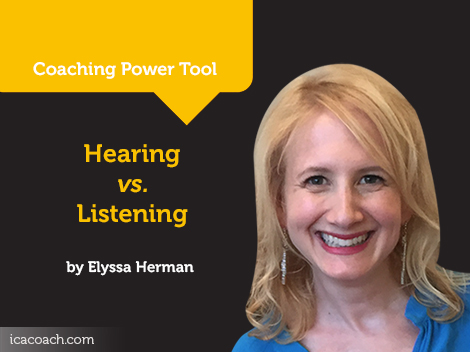
A Coaching Power Tool Created by Elyssa Herman
(Executive Coaching, USA)
Hearing vs. Actively Listening
To hear is an involuntary process of sound vibrations that flow from the eardrums and travel into the brain where the sound is received, in some cases paid attention to, in some cases applied, and in some cases stored and remembered.
To actively listen is a voluntary act of hearing what another person is saying while being completely present in the moment of the conversation without distraction.
In coaching, hearing is simply not enough. In the words of Ram Dass, “Be Here Now.” If we are not living in the present and actively engaging with it, we are living in the past or future. Everything has its time and space but the present is all we have now.
In this world of 30 second sound bites, instant messaging, Twitter and Facebook, it is easy to get distracted and to multi-task. The expense of this, however, often means that we are only ever partially present and listening.
Often when we hear, we are hearing from our own lens, our own sense of knowing what is right from wrong, our own tunnel vision. It comes from a place of tolerating another person’s communications rather than welcoming it. There is a barrier of communication when someone is hearing but not actively listening. The barrier often comes with the message of “I already have my opinion formed” or “What I am doing right now is more important than what you have to say”.
When we meet someone and form a judgment, it often is based on a multitude of factors, conscious and not. We generally get a feel for the other person and form an opinion of how important what they say is to us and therefore decide, how actively we want to listen to them. Then, the next time we see them, we come into the conversation with the lens that we borrow from the last time(s) we met with them and assume that everything they say is going to be pretty much along the same lines as the story we associate with them. The danger in this is that it does not allow for the other person or you as the listener to change, evolve, or grow and assumes there is no possibility for that. Therefore, if someone was having a bad day, and that was the day of your first encounter, chances are, they won’t get much of a second chance on that next encounter an incredible opportunity could be missed.
Self-Application:
Listening can mean internal listening – being in touch with your own thoughts long enough to think them, feel them, and process them. This means listening to your own stories and challenging them. This means listening to patterns and self-limiting beliefs and not diverting from them when they are scary. Practicing active listening with oneself often creates mindfulness, which in turn, allows for greater self -awareness and empathy to more actively listen to others.
Coaching Application:
To be a great coach, it is essential to actively listen to a client without distraction and to look for the gold in what they are saying. It is important to listen to words, tone, body language if in person, attitude, and variations in these from session to session to notice patterns. When a coach is fully present and can reflect back to a client what they heard the client say, the client feels greater trust with the coach and therefore has the safe space to open up and be vulnerable with that coach. A coach’s active listening can foster a client to feel understood, supported, and enable them to dig deeper into their limiting beliefs and “stories.” By listening to the client each time with a pure lens of taking in what they are saying, the coach is able to empathize with the client and acknowledge their successes.
Reflections:
- Can you identify people in your life to whom you actively listen vs. those you “hear”?
- What would happen if you came into a conversation with someone you usually just “hear” with a reframed mindset and actively listen to what they say? Is it possible your relationship with them could change?
- Can you tell when someone is listening to you actively vs. hearing you? How does it feel in both cases?
- What messages are you sending to those around you when you are just hearing them?